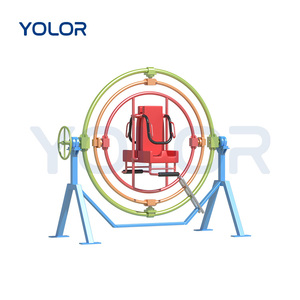(29360 products available)

































































































































































































A gyroscope is a device that measures or maintains orientation and angular velocity. It is used in navigation, smartphone orientation, and space applications. There are several types of gyroscopes, each serving a unique purpose. Here are the main types:
Gyroscopes are utilized in various applications that require the measurement or maintenance of orientation, location, or angular velocity. Here are some key applications:
Aerospace
Gyroscopes are crucial in aerospace applications because they help navigate and stabilize aircraft and spacecraft. For instance, they provide accurate orientation and angular velocity data for the inertial navigation systems of airplanes and satellites. Moreover, spacecraft attitude control systems use gyroscopes to stabilize and orient spacecraft during flight and after reaching orbit.
Automotive Industry
Gyroscopes are crucial in the automotive industry for stability and navigation. For instance, they are used in electronic stability control systems to detect and reduce loss of traction by measuring the vehicle's orientation and rate of spin. Also, gyroscopes are used in navigation systems, such as GPS, to provide accurate position and orientation data, especially in scenarios where the vehicle is making sharp turns or changes in direction.
Consumer Electronics
Gyroscopes are used in consumer electronics, such as smartphones, tablets, and gaming consoles, for various applications. For example, they enable screen rotation, allowing the display to switch between portrait and landscape modes based on the device's orientation. Additionally, gyroscopes enhance gaming experience by providing motion sensing and control in video games.
Marine Applications
Gyroscopes are also used for stabilization in yachts and ships. For instance, marine gyroscopic stabilizers reduce the roll motion of vessels caused by waves, improving comfort and reducing sea sickness. Additionally, gyroscopes are used in inertial navigation systems for submarines and surface vessels, providing accurate orientation and position data in environments where GPS signals may be unavailable.
Robotics
Gyroscopes are essential in robotics for balance and orientation. For instance, they are used in robotic arms and humanoid robots to maintain stability and accurately control movement. Moreover, gyroscopes assist in navigation and path planning in mobile robots, enabling them to move and operate efficiently in various environments.
Virtual Reality (VR) and Augmented Reality (AR)
Gyroscopes are used in VR and AR headsets to track the orientation and movement of the user's head. This provides a realistic and immersive experience by ensuring that the virtual environment is accurately aligned with the user's perspective.
When buying gyroscope sensors for sale, it is important to know what one's target customers need. Different applications need different kinds of gyroscopes. Here are some factors to consider when buying gyroscopes:
Application
As mentioned, different applications require different kinds of gyroscopes. For instance, aviation, marine, and automotive industries require angular velocity gyroscopes with high precision and stability. On the other hand, consumer electronics requires compact and cost-effective gyroscopes.
Type
As mentioned, there are several types of gyroscopes. They include mechanical gyroscopes, optical gyroscopes, and MEMS gyroscopes. Buyers should ensure they stock the types that their customers need.
Performance
Buyers should look for gyroscopes with good performance specifications. These include bias stability, noise, and drift. Customers will want gyroscopes with low noise and low drift to improve accuracy.
Size and Integration
In many applications, especially consumer electronics, how a gyroscope integrates with other components is very important. Buyers should get gyroscopes of varying sizes to give their customers options. Some customers will want standalone gyroscopes, while others will want integrated solutions with accelerometers and IMU.
Power Consumption
Gyroscopes consume a lot of power, especially when it comes to IMU units. Many applications, such as portable devices, require low power consumption gyroscopes. Buyers should look for units with low power consumption specifications.
Cost
Buyers should get gyroscopes of different price ranges. While high-end applications will require costly options, other applications will need cost-effective options.
Calibration and Maintenance
Gyroscopes drift over time, and some more advanced options require regular calibration. Buyers should get gyroscopes that are easy to calibrate and maintain.
Reliability and Durability
In some applications, reliability and durability are very important. Such applications will require gyroscopes that can withstand harsh conditions and have a wide operating temperature range.
Q: How many types of gyroscopes are there?
A: There are three types of gyroscopes: mechanical, optical, and virtual. Mechanical gyroscopes use physical spinning wheels to detect orientation. Optical gyroscopes use light waves, while virtual gyroscopes use digital sensors.
Q: What is the main function of a gyroscope?
A: A gyroscope's main function is to measure or maintain orientation and angular velocity. It does this by detecting changes in motion and orientation.
Q: Can a gyroscope measure acceleration?
A: No, a gyroscope cannot measure acceleration. However, it can measure angular motion or rotation speed.
Q: What is the difference between a gyroscope and an accelerometer?
A: A gyroscope measures rotational motion, while an accelerometer measures linear acceleration in various directions. A gyroscope helps determine how much a device has rotated, and an accelerometer helps determine how far a device has moved.